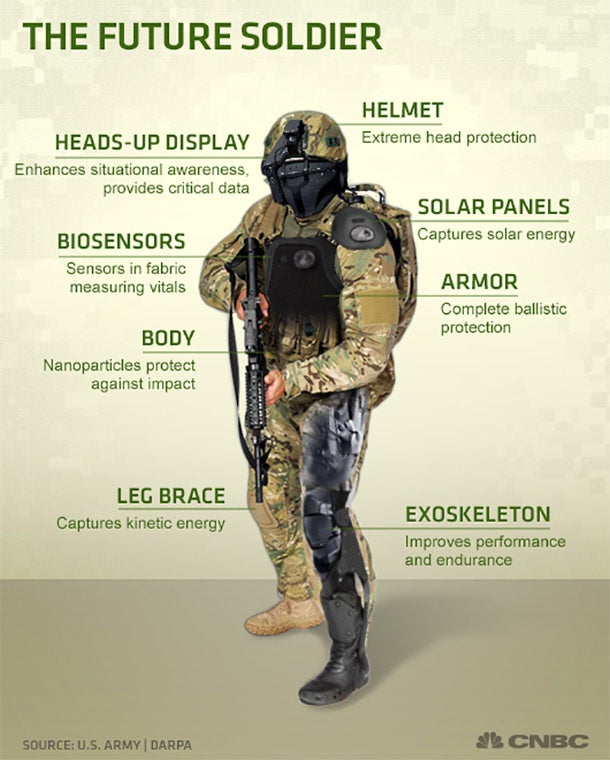The Soldier of the Future Looks A Lot Like Science Fiction The U.S. Army's TALOS team is working to create technology that will bring together man and machine.
This story originally appeared on CNBC
Forget an Apple iWatch, the U.S. military is the one really taking wearable technology to new levels.
Different divisions of the U.S. armed forces, as well as other government agencies such as Darpa, are all working on developing high-tech armor that will help not only provide soldiers with full-body ballistic protection, but will also give them superhuman-like capabilities.
Think enhanced vision, increased upper body strength, improved speed and even amplified situational awareness.
Some of the technology that the soldier of the future may wear could include advanced sensors, that can respond to brain functions; smart fabrics that could provide hemorrhage control; and a heads-up display that could provide real-time battlefield data. An exoskeleton that enhances physical performance—and also captures kinetic energy to power the soldier's attire—could also be part of the future uniform.
Although this might sound like something straight out of a scene from a science fiction movie, it's actually not that far off from becoming a reality.
TALOS
The U.S. military is currently working on a system called the Tactical Assault Light Operator Suit (TALOS)—which is aimed at providing greater ballistic coverage as well as increased strength—for Special Operations troops.
"The next 20 years are going to be transformational years," said Michael Fieldson, the program manager for TALOS.
The first TALOS prototype is expected to be delivered in June, and a fully functional version is expected to roll out to U.S. Commandos by 2018.

By 2039, the suit could have many of the advanced capabilities mentioned, if not more.
The TALOS team is currently working with a slew of companies on the TALOS vision including defense contractors such as Lockheed Martin,Raytheon and Boeing. It's also partnering with some unexpected companies including Nike, Adidas and Under Armour.
"We are able to solicit broad participation from non-traditional partners, and what that does is lower the development costs and increase the deployment timeline at bringing in new technologies," Fieldson said. "And this kind of collaboration could rev up the kinds of technology that are possible in the next 20 years."
Although TALOS is often referred to as the "Iron Man" suit, the military is actually working to make the uniform as lightweight, durable and discreet as possible.
"Twenty years from now will everyone have space boots? Probably not, it will be much more effective equipment that is lighter than what general purpose forces have today," Fieldson said.
Merging man and machine
Machines and mankind will merge as technology advances, and that will mean a heap of benefits for soldiers in battle, said Tod Lovell, a technology director at Raytheon.
One of the goals of the TALOS' team is to use antennas and computers embedded into the suit to help increase situational awareness.
For example, if a soldier is looking in one direction, the technology in the suit would sense that and alert the wearer if something was awry in another direction.
It may communicate this through a vibration, or it could even alert the wearer via a message displayed in a heads-up display.
In other words, the technology in future armor will really complete humans, Lovell said.
"The really cool thing is that technology is going to start really paying attention to the state of the human," Lovell said. "It won't just be the human operating part of the technology. The human will be part of that system. The system would adapt to the human."
Computers on the inside
Some of the technology may even be placed inside of the soldiers' bodies.
"Twenty-five years from now, we may be to the point where the sensors are embedded in the skin and the person becomes the processor," Lovell said.
The company MC10 is already building "conformable electronics," which mesh with a person's skin much like temporary tattoos. These electronics contain sensors that can monitor data from the brain, muscles, heart as well as other biometric information.
#insert RSS here#
Although the company is in the process of applying to work on TALOS, it already has military partnerships, including a project it is about to begin with the Air Force where it will put patches inside clothing that will monitor things such as indicators of stress and fatigue, said Barry Ives, director for MC10's advanced programs and military.
The company also uses its flexible, ultra-thin electronics to make solar panels that can be embedded into clothing. It has partnered with the Army to test the flexible energy harvesters, which are placed on soldiers' helmets, rucksacks and other gear. The goal is to create enough energy to power soldiers' devices when they're in the field.
But whether these types of flexible electronics are embedded in the skin, or in a soldier's clothing, it's clear that new technology like this is going to be used.
"As you look out 25 years, I'm not sure we know or will even recognize the things that will come out," Lovell said. "But I think a lot of the new science—the quantum computing, lower power devices and advanced sensors—they are going to continue to change the game."










